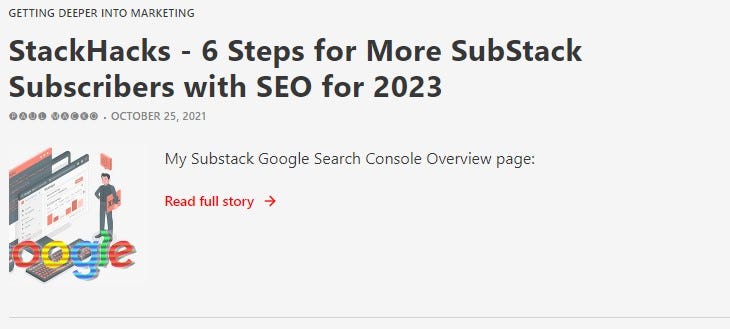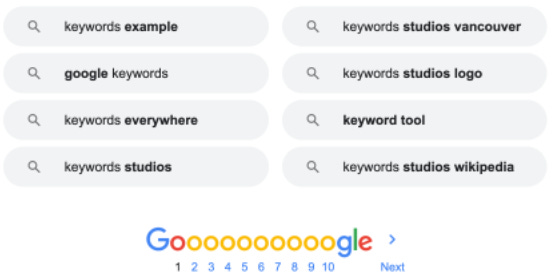SEO - The DIY - Set up SEO Course for Substack Writers
The DIY - Set up SEO Course for Substack Writers
Post Settings:
Bottom Right of page when you are in your page editor:
Settings:
Internet Marketing Acronyms
To help you master the digital Marketing/Advertising world, I’ve compiled a list of acronyms you’re sure to come across on a regular basis. From basic terms to more specialized jargon, this list will build your vocabulary and help you navigate the digital advertising industry. Also known as
StackHacks - 6 Steps for More SubStack Subscribers with SEO for 2023
How to set up on-page SEO for your SubStack Articles the FREE and EASY way!
Keywords:
Find Free Keywords:
The Google search bar will auto fill the most searched terms for you as you type. Save the suggested words and phrases (called long tail search terms) and use those keywords in your article. At the bottom of the first page of Google results you will find more suggested terms. Like this:
More free: FREE Backlinko Keyword Research Tool, AHREFs Free Keyword Generator, Answer the Public, Uber Suggest, Keywordtool, Keyword Surfer Chrome Extension, The Reddit Keyword Research Tool, Google Ads Keyword Planner, Google Trends.
Valuable (but Not Free): but one of the best for newsletters/blogs: RankIQ (just $49/mo)
More about keywords:
Using Keywords to Improve your SEO and Get Your Content to the Front Page of Google
Using Keywords is one of a number of techniques to optimize your SEO Search Results. And it is one of the most important. Here are a few easy things to do while writing your newsletter posts: How to Get Your Substack Articles to Rank Higher on Google
Use ChatGPT to find Keywords
How you can create a Keyword Strategy with ChatGPT. Which is free for all to use now at https://chat.openai.com/ Enter the following Prompt: ”Pretend like you are a market research specialist having accurate and detailed information about available keywords. You are also capable of developing a ful…
Steps to Install Google Search Console
Here's a step-by-step guide to install Google Search Console for Substack writers: 1. Sign Up/Login to Google Account: Visit the Google Search Console website (https://search.google.com/search-console/) and sign in with your Google account. If you don't have one, you'll need to create an account.
1) https://pau1.substack.com/p/6-steps-for-more-substack-subscribers
Optimize your SubStack or any other Newsletter (Medium, Ghost, WordPress…) for Google with SEO (Search Engine Optimization) by:
A Unique Domain Name instead of XXX.substack.com
How to Choose a Domain Name that works for SEO and Branding
How to Find and Implement Keywords for Free (see above for deeper explanation)
How to format and use Alt Text
How to add one Heading 1 tag <H1>
Get others to Link to your articles
2) https://backlinko.com/google-seo-guide
3) https://backlinko.com/google-ranking-factors
Quality Content: The most important SEO factor. Google wants to show users high-quality, informative, and relevant content.
Backlinks: Links from other websites to your website. They act like votes of confidence. The more high-quality backlinks you have, the higher your website will rank.
Technical SEO: The technical aspects of your website, such as its website speed, mobile-friendliness, and crawlability. Make sure your website is technically sound so that search engines can easily index and understand your content.
Keyword Optimization: The process of using relevant keywords throughout your website’s content. This helps search engines understand what your website is about.
User Experience (UX): A measure of how easy and enjoyable it is for users to use your website. Google wants to show users websites that provide a good UX.
Schema Markup: A type of structured data that you can add to your website to help search engines better understand your content.
Social Signals: The likes, shares, and other social interactions that your website’s content receives. Make sure your website is shareable and encourages social interaction.
Brand Signals: The overall perception of your brand online. Make sure your brand is well-known and respected.
4) https://pau1.substack.com/p/the-seo-list
5) https://pau1.substack.com/p/stackhacks-get-more-readers-all-4
Part 1 shows how and why you should consider Re-Submitting your SubStack articles to:
Tumblr
Blogger
Medium
Reddit
Hacker News
Quora
How and why to use Twitter Threads
Part 2 shows how and why you should consider Re-Submitting your articles to:
Flipboard
LinkedIn
Pinterest
and How to Contribute to Online Forums
Part 3, we will show hundreds of places to find guest blogging opportunities.
Part 4, we will show you how to Re-Purpose your posts by turning them into different types of content:
PDF Files
Infographics / Listicles
Podcasts
Audiobooks
Videos
Animated Presentations
eBooks
Courses
Webinars
QR Codes for T-Shirts, Stickers
Contact Paul if you are interested in taking this course.


















